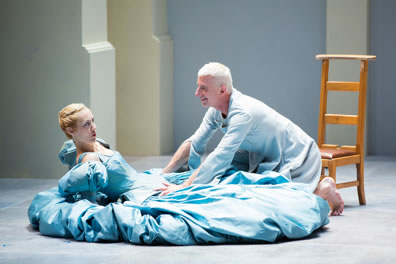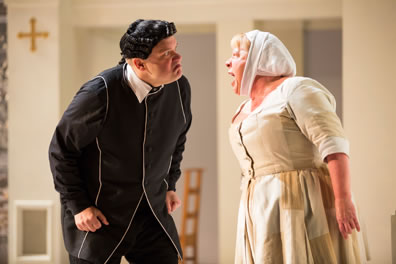Tartuffe
Discomforting Comedy, Hypnotic Theater
By Molière, adapted by David Ball
Shakespeare Theatre Company/South Coast Repertory/Berkeley Repertory Theatre, Sidney Harman Hall, Washington, D.C.
Wednesday, June 10, 2015, H–108&109 (center stalls)
Directed by Dominique Serrand
The cobra is one of God’s most lethal creatures. It also is one of his most fascinating, rearing up when it is ready to strike, spreading its hood in a serpent version of the peacock’s tail, whipping its tongue out, and mesmerizing its victim. Yet, the cobra meets its match in the mongoose, the little rodent immune to snake venom that uses agility and bluffing to outlast and eventually wear down the hooded serpent.

Elmire (Sofia Jean Gomez) fends off Tartuffe (Steven Epp) in their first seduction scene of Molière's Tartuffe at the Shakespeare Theatre Company. Below Orgon (Luverne Seifert, left) and Dorine (Suzanne Warmanen) release the nitroglycerine. Photos by Scott Suchman, Shakespeare Theatre Company.
I was watching such a pas de deux the other night in the Washington, D.C., Shakespeare Theatre Company’s production of Molière's Tartuffe (a coproduction with two California theaters, Orange County’s South Coast Repertory and the Berkeley Repertory Theatre). Steven Epp is the hypocritically pious title character, slithering across the stage as he tries to seduce his benefactor’s wife, Elmire, played by Sofia Jean Gomez. With super-supple agility, combining quick wit and yoga-slow body movements—craning her neck this way, arching her back that way while her body is folded under an elegant French gown spread out on the floor—Gomez’s Elmire parries with Tartuffe. Most of the action in this scene, one of two pivotal tête-à-têtes between these two characters, is played out on the ground: two throw rugs maneuvering like cats preparing to fight. Though much of this was funny, at no point did we lose sight of the danger in their contest.
Other than labeling Tartuffe as Molière's bitter satire on religious hypocrisy, this is a play you can’t pigeonhole, and this production is as discomforting as it is funny. The rhyming lines of Tartuffe make you laugh, especially the railings of housemaid Dorine, played with brilliant comic pacing by Suzanne Warmanen. Recounting how Tartuffe scolded her for using a handkerchief as a bookmark in her Bible, Dorine concludes, “If a handkerchief can insult God, God needs more self-confidence.” However, even as you laugh at them, the characters leave you shuddering with an ill chill, especially Tartuffe with his ultrapious gestures and expressions. We know his extreme religious fervor all too well, in Middle East jihadists, book-burning Florida evangelists, or other adherents to religious orthodoxy who scare the hell into us. As Tartuffe relays what heaven tells him, messages that don’t stand the test of logic, we recall politicians enveloping themselves in “God’s will” as if they have a red Batphone to the Almighty. And like Tartuffe, jihadists, ultrafundamentalists, and ultraorthodoxes all eventually expose themselves as criminal cons, power-hungry egomaniacs, and irreligious bullies (inevitable because they ignore the lessons of love and tolerance at the heart of their particular religion’s holy writs).
Equally frustrating are the blind believers these pious hypocrites prey upon and use to amass their power base. Madame Pernelle, the old grandmother played by Michael Manuel, opens the play with a comical diatribe against her family for resisting Tartuffe’s “positive” influence on the household. Equally funny but much more dangerous is the blind belief in Tartuffe of Madame Pernelle’s son, Orgon (Luverne Seifert), reputedly the wisest man in all of France and the head of the household. Beyond enforcing Tartuffe on his family—insisting his already-betrothed daughter marry Tartuffe and ordering his wife to maintain close contact with the man of piety—Orgon ends up legally turning his estate over to Tartuffe. Too late can anybody get through to Orgon, though they try hard via calm reasoning (Elmire’s brother, Cleante, played with easy grace and stoicism by Gregory Linington), loud arguing (Dorine, who has a lifetime of credibility with Orgon that allows her to defy her master), and pleading whimpers (daughter Mariane, played with her own brand of petulant hypocrisy by Lenne Klingaman). Orgon wants visual evidence of Tartuffe’s impiety to disprove the great visible evidence of his piety, and only by Elmire sacrificing herself to a second seduction battle with the cobra in Orgon’s presence does her husband finally see the truth. When he does, he recognizes the greater truth of Tartuffe’s grand trap. In the face of ruin, Orgon tries to get through to his mother the reality that is Tartuffe, but she yet refuses to accept the testimony of even her hitherto devoted-to-Tartuffe son and casts him as a sinner like all the rest. “How can anyone not believe this?” an incredulous Orgon shouts, drawing ironic glares from the rest of his household and knowing laughs from the audience.
As discomforting as Molière's script is Director Dominique Serrand’s staging of it. The physicality of this production is one of its most entrancing aspects, blending elements of commedia dell’arte with modern dance but containing it all in strictly controlled stillness and measured motion—think of the intense energy of a hamster that has drunk too much Mountain Dew bottled up in the grace of a cat stretching after a nap. This bottled-up energy gives the whole production a relentless edginess. Long, silent pauses punctuate conversations, two characters intently staring at each other while pushing the audience’s patience to nervous titters. Only occasionally does the nitroglycerin explode through its human containers, especially in Orgon trying to practice pious patience against his true impetuous nature. The only slapstick scene is Klingaman’s Mariane breaking off her engagement with Valere (Christopher Carley) as they force themselves to hurl insults at each other against their own intentions (both trying to put a brave face on their splitting up with each other).
While the first Tartuffe-Elmire scene is fascinatingly titillating (almost against our desire that it be so), in the second encounter, Elmire is playing the seduction card herself in order to trap Tartuffe. Consequently, Gomez’s mongoose loses her moral advantage, and Epp’s Tartuffe slithers through her opened defenses. The verbal dance crosses the line into physical sexual assault (the production carries a “recommended for mature audiences” notice). Though we are laughing at a running joke—how far will Orgon let his wife be violated—we are cringing at the resulting violation. In such ways does Serrand play out Molière's thematic purpose in our very selves rather than as some distancing farce behind a fourth wall.
All of this action and pertinent nonaction takes place in the barely furnished parlor of Orgon’s Parisian mansion (Serrand and Tom Buderwitz are the scenic designers) over the course of a single day represented in the sunlight coming through the windows to one side of the stage (brilliant lighting design by Marcus Dilliard). Sonya Berlovitz’s costume designs are all over the cultural spectrum through time, ranging from the tapestry pajama-like outfit worn by Valere and Mariane's 1950s-era bright party skirt to Elmire’s elegant six-foot-wide, bare-shouldered blue ball gown and Tartuffe’s plain, single-colored tunics that unbutton across the top of the chest (but keeping the collar intact) to bare his breast when he blends his piety with sexual seduction.
The production runs 2:15 (plus a 15-minute intermission), but the title character doesn’t show up until a third of the way into the play. Yet he is the subject of all conversation, setting us up for a grand entrance, like Don Logan in Sexy Beast. Notably, when Epp finally enters, it is through the audience. He immediately establishes his piety for us by flogging himself; the only other characters on stage are his servants and henchmen, most notably, Laurent. Played by Nathan Keepers, who is also the production’s assistant director, Laurent channels Alan Cumming's Saturninus in appearance and Tartuffe himself in his coiled movements.
 Despite this show of piety for our sakes, we soon understand that this Tartuffe is the reptilian creep the majority of characters report him to be. We get this not only in Epp’s movements but also his occasional but confident glances at the audience—he considers us in his game. Beyond his slithering on the floor when engaging with Elmire, Epp’s other cobra-like behaviors include winding around his victims and suddenly rising over them (or under them) from angles they don’t expect; snapping his mouth shut in a threatening manner; and much tongue action, flicking it about and licking his chalice, licking the mouth of Orgon’s dispossessed son Damis (Brian Hostenske portraying hot-headed cowardice and hyperkinetic frustration), and licking Elmire’s feet.
Despite this show of piety for our sakes, we soon understand that this Tartuffe is the reptilian creep the majority of characters report him to be. We get this not only in Epp’s movements but also his occasional but confident glances at the audience—he considers us in his game. Beyond his slithering on the floor when engaging with Elmire, Epp’s other cobra-like behaviors include winding around his victims and suddenly rising over them (or under them) from angles they don’t expect; snapping his mouth shut in a threatening manner; and much tongue action, flicking it about and licking his chalice, licking the mouth of Orgon’s dispossessed son Damis (Brian Hostenske portraying hot-headed cowardice and hyperkinetic frustration), and licking Elmire’s feet.
During the individual bows of the curtain call, some in the audience actually booed Epp. I took this as a judgment on the character of Tartuffe rather than on the playing of that character (though his fellow actors, those not laughing along with him, were astonished by the reaction and applauded Epp themselves). However, this reaction also sums up the inner conflict many in the audience might have been feeling throughout the production. There were a few walk-outs, and I can only speculate on why, but around us I sensed some audience members were uncomfortable with blasphemous lines in the script, others uncomfortable with Epp’s portrayal of a “pretender who promotes piety for profit” as Cleante calls him, and some disappointed that this wasn’t a rollicking fun Molière that even I was expecting. In the end, though, the applause of those who remained was fervent.
For this is a production with impeccable acting via studied line readings and precision movement showcasing the incisive stagecraft of Serrand’s direction. It had us laughing in our hearts, troubled in our souls, titillated in our guts, and hypnotized.
Eric Minton
June 12, 2015
Comment: e-mail [email protected]
Start a discussion in the Bardroom



 Find additional Shakespeareances
Find additional Shakespeareances